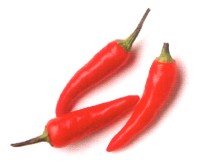Chilli peppers
The New Mexico Chile Pepper Institute can tell you all about growing and eating chilli peppers.

The most common way to test chile pungency is to taste the pod, this method, although quick and cost effective, may leave the tester in some pain. There are two other ways of testing pungency as well, the Scoville organoleptic test and high performance liquid chromatography.
The Scoville test is a refined, systematic approach. It was the first laboratory approach used to measure pungency in chiles. In this method, human subjects taste a chile sample and record the heat level. The samples are diluted in the laboratory until heat can no longer be detected by the tasters. This dilution is called the Scoville Heat Unit. This procedure can be appropriate in many circumstances, as it is more accurate than the taste test (“bite the chile”) technique. This test is also less expensive than more advanced laboratory techniques, but this method has limitations. Measuring pungency with this technique is still subjective and depends on the taster’s palate and sensitivity to the chemicals that are responsible for pungency. In addition, there are serious limits on how many samples a taster can handle within a reasonable time.